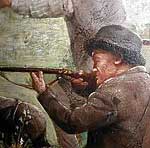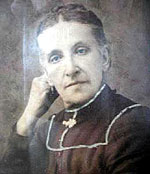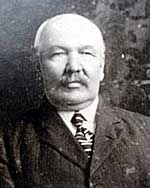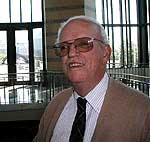By Mark Steil and Tim Post
Minnesota Public Radio
September 26, 2002
| |
|
|
|
||
The German settlement of New Ulm was the center of resistance against the Dakota in 1862. These days, the glockenspiel in downtown New Ulm attracts a crowd of tourists to its noon concert. Many of the tourists will also visit battle sites from the 1862 war.
The Dakota attacked New Ulm twice - on Aug. 19 and Aug. 23. Darla Gephard works with the Brown County Historical Society. Gephard says Charles Flandrau was in charge of the city's defense. Standing on a downtown sidewalk, Gephard describes a key moment.
"If you look kitty-corner across the street, from the barricades was the Kiesling Blacksmith Shop. The Dakota, by this time, were inside that blacksmith shop. And Flandrau said, 'If we don't make a stand they're going to come out of the blacksmith shop, go over the barricades and they're going to take the town,'" Gephard tells the story. "So they did get a group of men that finally went over the barricades themselves, and flushed the Dakota out of the blacksmith shop, and burned it to the ground. And he said that was a turning point in the battle - it was the first time that they felt that they were not on the defense."
| |
|
|
|
||
Joining the residents of New Ulm were hundreds of settlers fleeing the Dakota assault. Free-roaming bands of Indians broke off from the main war army to attack farms and travelers. Settlers were killed in places with names like Acton, Milford and Slaughter Slough.
There's never been an official report on the number of settlers killed, but estimates range from 300 to 800. Historian Don Heinrich Tolzmann says until the terrorist attacks of Sept. 11, 2001, it was the highest civilian wartime toll in U.S. history.
Alan Woolworth studied the 1862 war for more than 40 years. Wooloworth was curator for the Minnesota Historical Society. He says the settler killings are still controversial.
"This is a very sore point with my Dakota friends. We simply don't discuss it," says Woolworth. "The whole conflict was a tragedy. No one won it. The Dakota Indians lost everything. Their society, their world was destroyed. They were scattered. Many hundreds and thousands of white settlers fled, and many of them had very bitter memories of this event."
| |
|
|
|
||
Woolworth says one explanation for the attacks on settlers is that the Dakota were doing what they had always done in war: kill or capture everyone in their path. The question of whether the settlers were the victims - or the cause - of the war is still debated.
"In 1862, there really were no innocent white settlers in Minnesota," says Angela Cavendar Wilson, who grew up in the Minnesota River Valley.
Wilson's home is steeped in Dakota tradition. She admits her views are controversial. She says whether they knew it or not, settlers were part of a government policy to drive Indians from their traditional lands.
"When whites came to Minnesota they came either knowing, believing, or hoping that the Dakota would be exterminated or forcibly removed," Wilson says.
Most descendants of settler families disagree. They say German immigrants fresh off a trans-Atlantic boat had no knowledge of government-Indian politics. Many settlers had Dakota friends. Mary Blank says her great-grandfather once spent the night with a Dakota family. She says he often played with Indian children before the war.
| |
|
|
|
||
"I really believe that if my great-grandfather and his parents had not befriended the Native Americans - days and months before this all took place - I wouldn't be here speaking about it," says Blank.
Many Dakota rescued white settlers. The most famous, John Other Day, led more than 60 settlers to safety. Still, the death toll was high. When he was an old man, Mary Blank's great-grandfather, Christ Spelbrink, wrote an account of the war.
"Floriau Hartman was working in the field when his wife came through the cornfield to bring him some refreshments, when she saw to her horror, her husband shot down and two Indians a short distance away. As Hartman was not dead but unable to move, she ran to him and tried to drag him into the nearby cornfield - which she was unable to do and so had to leave him to his terrible fate," Spelbrink wrote.
Most of the settlers were killed on the first day of the war, Aug. 18. Several hundred more were captured and held by the Dakota until the war ended in late September.
The killings triggered an avalanche of bad press for the Indians. Most newspapers demanded all Dakota be executed or removed from the state. But some of those closest to the war were not so vengeful - Christ Spelbrink for one. Mary Blank reads from her great-grandfather's writing.
| |
|
|
|
||
"For all the talk that the cause of the outbreak could not be determined is nothing but rot, pure and simple. For had the Indians been treated as agreed, honest and upright, this bloody day in Minnesota's history would have been avoided. But as it was, the Indians never had a square deal," Spelbrink wrote.
After the war the surviving settlers had a hard time, especially orphaned children. Brown County historian Darla Gephard says damage payments were made, but little trickled down to the orphans.
"Not having any inheritance or money left when they did become 18. Even though they knew that their parents who were killed in the Dakota war had owned a farm, that farm was gone when they came of age. And if you look at our tax rolls after 1862, you see tax forfeiture sales all over the place," Gephard says.
Time softened the jagged edges of war for most of the settlers. Minnie Buce Carrigan was a little girl when she was captured and held for six weeks by the Dakota. Forty years after the attack, she wrote about the war and the friends she lost. Any bitterness was replaced with a longing for the scenes and images of childhood.
"The creek near our home, where the lovely white cherry blossoms were so thick that they looked like a white sheet. Little Pauline and Minnie Kitzmann, my sister Augusta and I often brought our aprons-full home to make garlands out of them. Years after, when I used to see the white cherry blossoms, I used to wish that I could go back and cover the graves of my little friends with the flowers they loved so well," wrote Carrigan.
More from MPR




